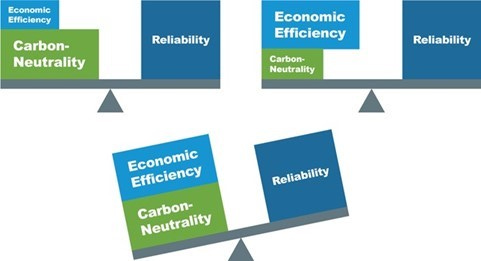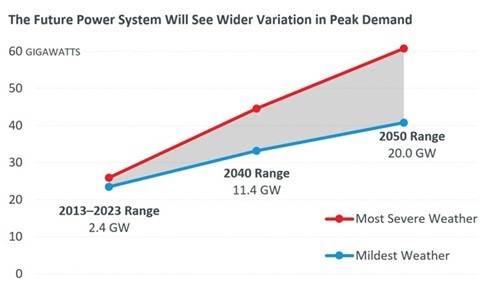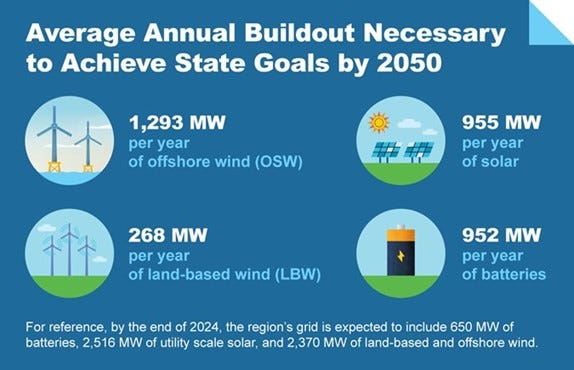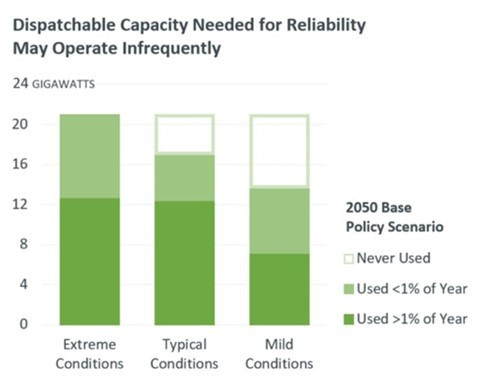Energy Musings - ISO-NE's Future Plans
We analyze an ISO-NE report on planning the future grid for a clean energy transition for the six state New England region. This will be a multi-article review.
This is the first in a series of articles about a new ISO-NE report on the possibilities and challenges of the clean energy transition for New England. This article covers the report’s main themes – the challenge of balancing the grid, the future variability of power demand, and the adequacy of future power supply. Next, we will deal with decarbonizing the grid and the continued need for dispatchable power. It will also look at the impact of a grid powered by offshore wind on New England’s maritime environment. We also plan to assess the economics of the clean energy transition and what its proponents fail to tell the public about the cost and lifestyle impacts.
Decarbonizing New England’s Power Will Be Expensive
An August 22, 2024, blog post by New England’s independent system operator of the region’s electricity grid (ISO-NE) “highlights possibilities and challenges of the clean energy transition.” Unmentioned is the cost. Or even whether decarbonization is feasible in the next 25 years.
The blog prompted an article in the Utility Dive newsletter. It, too, mentions the possibilities and challenges but only from a high-level perspective. We expected a more in-depth analysis, especially because cost and feasibility are critical issues. Ratepayers will be footing the bill for the transition, so, one expected a warning about the impact on future electricity bills. Furthermore, there is no discussion of the increased risk of blackouts during and after the transition. Another risk that ratepayers should understand.
The ISO-NE blog highlighted a recently completed report titled Economic Planning for the Clean Energy Transition (EPCET). Surprisingly, the blog linked to a draft report, but we assumed it was because a committee needs to sign off on the final version.
Reading the report was sobering, and frankly concerning. It was based on a two-year research effort, which we are told was supported by 33 published scenarios and more than 2,800 simulations. To do justice to the study and the issues raised, we decided to cover it in multiple articles. So, stay tuned.
First, we will summarize the three bullet points that headlined the Utility Dive article. Presumably, these points represented the most important issues the author took away from reading the ISO-NE blog.
1. There may need to be a “vast renewable build-out.” As much as 97 gigawatts (GW) of new wind, solar, and battery capacity needs to be built by 2050 to reach the decarbonization goals of the six states comprising ISO-NE. [To add perspective, as of January 2024, the ISO-NE grid had a 30GW capacity.]
2. Each of the six New England states has a policy to cut carbon emissions by at least 80% from 1990 levels by 2050. They plan to use renewable energy to electrify the region’s heating and transportation systems. Electrifying everything will shift New England’s electricity demand peak from summer to winter by the mid-2030s. Winter will also have two daily demand peaks in contrast to summer’s single demand peak. Additionally, the seasonal peak shift will create a wide disparity in electricity demand between mild and severe cold weather years.
3. Long-duration storage “may help meet high demand during shorter cold snaps.” But the region will also need dispatchable, zero-carbon generation such as synthetic natural gas or small modular reactors. By 2045, wind and solar resources meet just 10GW of the 51GW peak gross load during peak winter demand.
For many people, the Utility Dive article may be the extent of what we learned from the ISO-NE study. Why? Because the article is likely to be reported on by mainstream media outlets who will not bother to read the ISO-NE blog or its report. Importantly, the blog and report emphasized other key points about the transition’s challenges and costs. Let’s look at what the ISO-NE blog highlighted.
The blog observed that by 2050, the winter peak electricity demand could be 50% greater during a severely cold winter than a mild winter. Few people understand the significance of that statement. The grid requires a huge expansion to meet the electricity needs of a severe winter. Without sufficient electricity, the potential for a human disaster increases significantly. People could die.
Here are the ISO-NE blog’s key points:
1. Most paths to a low-carbon grid involve high variability in demand and supply.
2. Increased variability will require vastly different supply levels from year to year.
3. Emissions reductions will be seasonal. Some months will decarbonize years before others.
4. Renewable-only build-outs may be vast.
5. Current revenue structures may not adequately compensate resources for their value to the future grid.
6. Firm, dispatchable, zero-carbon generation could help address challenges.
Amazingly, the report had other points and observations overlooked by the ISO-NE blog and the Utility Dive article. For example, while they noted that renewable-only build-outs may be vast, the report emphasized that “later additions of renewable resources could have diminishing environmental and economic returns.” Therefore, ratepayers will be funding expenditures that will have little impact on the decarbonization goal and yield minimal economic benefits. Why should ratepayers agree to this spending? Because they aren’t told the whole story.
Another reported issue was the role of dispatchable power in meeting the variability of energy demand and the need for long-duration storage. The topic was addressed in the Utility Dive article and the ISO-NE blog. However, the report made the point differently. It stated, “Higher variability will increase the value of current and future dispatchable resources, including long-duration storage.” While some might say this is a semantic difference, the idea that dispatchable resources will be more valuable in the future hints at a systemic problem with the renewables solution. Renewable resources will see their value peaking and declining in the future while dispatchable resources become more valuable.
This conclusion was designed to introduce alternative long-duration energy storage options such as synthetic natural gas and small modular reactors. These will be expensive options and will take years to arrive. We believe SMR may be the most important of the two resources, but that is for another discussion.
The most important conclusion from the EPCET report was that “Difficult minimum load conditions, energy adequacy challenges, and potential system congestion may appear by the 2030s.” No one is telling the public that grid problems are on the cusp of emergence. Who is prepared for blackouts? No one is ready for sharply higher electricity bills to fund the desperate steps taken to prevent power outages.
Will state legislatures be forced to rescind their decarbonization goals once the public understands that adhering to them will prove disastrous?
Planning New England’s Grid
The goal of the EPCET report was to explain what is needed to decarbonize the New England grid by 2050. This is an aspirational goal. Unfortunately, the policymakers who enacted the decarbonization goals lacked an understanding of the physical limitations of the energy sources they propose to replace the existing hydrocarbon resources and power the grid of the future. They also lacked an appreciation of what it would take to reconstruct the existing power grid in 25 years – both technically and cost-wise. Again, failure is not an option.
The EPCET report stated that its key findings converge on a common theme - the future electricity grid must meet the standards people expect. It must be reliable, clean, and low-cost. This is what people demand of their electricity system, at a minimum. The report used different terminology but demonstrated the problem of balancing these three conditions in the following chart.
It is a challenge to manage the three grid qualities people demand.
In other words, if you are willing to yield to economic efficiency in favor of carbon neutrality, you can sustain a reliable grid. Likewise, you can emphasize economic efficiency and yield on carbon neutrality to achieve the same level of reliability. However, if you want economic efficiency and carbon-neutrality balance, you will not meet the reliability requirement.
The report summarized this challenge. “Given current technology and market structures, no single existing scalable resource type is highly reliable, inexpensive and carbon neutral. Future planning will require tradeoffs among these three factors.”
You cannot meet all three requirements – but which tradeoff is acceptable and who chooses? Should it be politicians, regulators, or the ratepayers? To date, the ratepayers have never been consulted.
The issue of tradeoffs is one many analysts examining future grid designs have raised only to be attacked for being obstructionists, deniers of the need for a change, or worse. We believe these analyses are based on sound footings in the physical sciences of the various energy resources, their costs, and their ability to deliver reliable electricity. Pointing out the need for difficult and unpopular decisions is frowned upon.
It is interesting to read the results of a two-year effort to assess the challenges of constructing the future grid. It touches on many of the issues we have considered. In reading various energy consultant reports focusing on the clean energy transition, we have seen caveats about the challenges of meeting the goals. However, these reports are seldom read and certainly not the subject of media articles.
Most of those reports were commissioned by state legislatures or regulators with specific agendas. On the other hand, ISO-NE has a responsibility to deliver electricity every minute of every day of every year to the people of New England. It is mandated to be prepared for the future under the set of conditions state regulators layout. ISO-NE’s failure to deliver power when needed would be a disaster for which it would be held responsible rather than the regulators or politicians who direct it.
Let’s dive into a couple of the issues and challenges.
New England Power Demand
The following chart shows the impact of the “electrify everything” policy on the region’s projected annual electricity demand in 2032. Besides the yearly totals, we see the electrify everything impact on summer and winter demand. Although total winter demand, excluding the electrification impact, is less than summer’s demand, the electrification impact in winter is nearly three times that of summer.
Winter is when the ISO-NE grid faces its toughest challenges in generating electricity. Natural gas fuels 60% or more of the grid’s generation, but that supply is reduced as a portion is directed to home heating. This forces ISO-NE to use expensive imported LNG and reactivate coal- and oil-fired generators, adding costs and worsening carbon emissions.
How New England’s power demand will shift.
It is noteworthy that this projected demand scenario is for 2032, eight years from now. We doubt the region can accomplish significant electrification of transportation and home heating within that time. This is because EV sales are not displacing internal combustion vehicles rapidly. Moreover, while heat pumps may replace oil and gas furnaces in new homes, homeowners are reluctant to replace existing heating systems until they are forced by aging furnaces. We assume the electrification impacts are calculated for that portion of incremental demand estimated by 2032 but not the full impact for 2050. Thus, the 2050 demand increases from electrification should be greater, along with some additional electricity demand from population and industrial growth in the region.
Power Demand Variability
Let’s turn to the question of annual demand variability. The report’s estimates are derived by forecasting electricity needs for the respective years and modeling them for each of the 20 weather years New England experienced during 2000-2020.
Addressing the challenge of managing the grid’s generating assets while meeting demand variability will have a cost. This increased cost is only mentioned in the report, not quantified.
New England electricity demand variability will be a challenge.
Under the mildest weather, the winter peak load increases from roughly 24GW in 2023 to about 32GW in 2040 and rises to 40GW in 2050. However, the most severe winter weather sees peak demand grow from approximately 26GW in 2023 to 43GW in 2040 and 60GW in 2050.
Looking at the peak demand spread, for 2013-2023, the spread between the mildest and most severe weather estimates equals about 10% of today’s grid capacity. The spread increases to about 40% of today’s grid capacity in 2040 and widens to 70% in 2050. The current grid has approximately 29GW of capacity, which must double over the next 25 years to meet the most severe weather year in 2050.
More than 1GW of additional generation capacity must be added each year to 2050, besides replacing the current capacity expected to retire. ISO-NE reports that since 2013, 7GW of generating capacity has retired or is planning to retire. The facilities identified as having already retired represent roughly 4.5GW, leaving approximately 2.5GW of capacity yet to retire. The yet-to-retire capacity must be replaced in addition to the incremental capacity that must be added to meet the projected power demand.
Under one scenario, EPCET calculates that 3.5GW of new capacity must be added annually to meet the states’ decarbonization goals. It assumes all the new capacity will be wind, solar, and batteries. That is a huge increase as it represents 12% of today’s grid capacity. It will prove expensive to achieve. How expensive? Let’s see.
In the following graphic, EPCET shows the annual renewables and battery power required for the grid to meet state decarbonization goals by 2050.
The additional renewable capacity needed by 2050.
Using the latest capital cost estimates from the Energy Information Administration’s Annual Energy Outlook, we find the batteries needed by ISO-NE will require an annual investment of $1.25 billion. Additional solar power will cost $1.27 billion annually, with onshore wind adding $460 million. The most significant renewable cost is offshore wind at $7.81 billion annually. Therefore, ISO-NE’s renewable energy capacity additions will cost $10.79 billion annually, or $270 billion over the next 25 years. Ratepayers will be on the hook for this investment.
We found it interesting that offshore wind capacity will require only about a third more than the solar power additions but will cost six times more. Offshore wind is promoted as the key renewable energy source for the region to meet state decarbonization goals. That is because New England does not have the land to build onshore wind farms. Since all the space needed for offshore wind farms is in the ocean, this is less objectionable. Presently, ratepayers have no idea how costly building and operating offshore wind farms are.
While some will say that spending $270 billion over the next 25 years to build renewable energy is a small price for a decarbonized grid, we wonder about the accuracy of these cost estimates. Additionally, other regional grids are suddenly discovering that new data centers and support for Artificial Intelligence software are exploding their electricity demand growth projections. Although ISO-NE’s demand growth has been modest in recent years, the region will have its share of new data centers and Artificial Intelligence facilities with huge power demands, more EVs and heat pumps, and possibly more residents. Therefore, we wonder if the projected power demand estimates will be accurate.
Grid Power Adequacy
A challenge highlighted by the report was not only the shift in peak demand from summer to winter but winter days will have two peaks – morning and evening. The projections are that the morning peak will be greater than the evening. That is because some of the coldest times of winter days occur at dawn, which is when people begin preparing for their day’s activities. These shifts represent firsts for the New England power grid and will present challenges for ensuring electricity adequacy.
This adequacy issue was highlighted in the underlying report by examining the potential swing in dispatchable load between extreme, typical, and mild weather conditions. To meet extreme conditions, all available generating assets will be needed. As a result, when typical conditions need less demand, some generating assets will be idled. In the mildest weather conditions, substantial generation capacity will be idled. Idling generating capacity carries a cost, which EPCET acknowledges in its bullet point that the current compensation system may be inadequate to assure electricity reliability.
Dispatchable capacity faces a compensation cliff.
The chart shows the impact on generating resources by depicting in white the capacity that will never be used. The light green area represents capacity to be used less than 1% per year. As the chart shows, in an extreme year, nearly 8GW of capacity, or almost 40% of total available dispatchable capacity will be used less than 1% per year.
In typical conditions, almost 20% of the capacity will never be used while another 20% is utilized less than 1%. The mild weather conditions create an even greater challenge for generating assets as nearly a third of that capacity is never used while another third is used less than 1% of the time. Only a third of the capacity is likely to work most of the time.
In a grid structure where generating assets seek to be paid, the prospect they might never be used, or used sparingly creates a dilemma for developers. How can they justify building generating assets with the risk they may not be used and therefore compensated? Such a scenario will force a dramatic revamp of the utility financing structure that will cost ratepayers untold sums.
We see this problem emerging with wind power. Because developers receive federal and state subsidies for each megawatt-hour of power they deliver, in periods when they have lots of wind power to offer, they will drive down hourly prices to force higher-cost generating assets off the grid making room for more of their power. This cannibalization of grid pricing can lead to periods of negative power prices offered by wind farms. They will drive the price down until the negative price nearly reaches their subsidy, at which point they will cease delivering additional power to conserve their turbines from wear and tear.
These periods of cheap and negative power prices are hailed for lowering electricity prices. However, driving dispatchable power capacity off the grid increases blackout risks. To protect against that risk, grid operators will keep dispatchable capacity operating to provide power when renewables fail because of the weather. This duplicate power system is partially to blame for sharply rising electricity costs and hurts the efforts to decarbonize the grid.
A possible solution is battery storage. The EPCET report commented on this solution.
“Recent ISO economic studies find that during the coldest days of the year, New England’s future grid may lack sufficient pipeline infrastructure to meet the region’s fuel demand for both home heating and power generation, creating a dependence on liquefied natural gas imports that may result in energy adequacy concerns. Other non-carbon-emitting energy storage technologies can help fill this void, but studies suggest the quantity of energy storage needed is infeasible from an economic and physical perspective, and the required storage resources would not have adequate opportunity to charge.”
It appears that ISO-NE understands that the battery storage option is “infeasible.” It strikes out based on economic, physical, and charging conditions. Does this mean there is an opportunity for another energy source to fill the gap, or are we destined to fail to achieve decarbonization goals?
In its modeling of the future grid, EPCET found that despite vast additions of wind, solar, and energy storage, there were still days and hours in 2045 and 2050 when significant dispatchable generation would be needed. Although the EPCET Policy Scenario does not include an in-depth resource adequacy analysis, another ISO-NE study does provide insight. That study examined a potential 2040 grid. It showed that by removing dispatchable generating capacity, the system required even more wind, solar, and energy storage to meet reliability criteria.
The modelers turned to the Stakeholder Requested Sensitivity study to evaluate the quantity of dispatchable resources the system needed for the forecast period. This resulted in a “resource adequacy check” step at five-year intervals over the study’s time. The check addresses whether additional storage would be required to meet energy shortfalls, or whether older generators could retire, assuming they were no longer needed for reliability.
Until the mid-2030s, the modeled system is resource-adequate. However, after that point, higher peak demand results in the system adding significant energy storage. That suggests the grid requires more dispatchable resources. The trend will continue through 2050. The following chart shows the increase in dispatchable resources each year on average to meet the expected demand increase from EPCET’s modeled 2025 to 2050 energy demand.
More dispatchable capacity must be built.
The conclusion is that more than 1GW of dispatchable capacity must be added annually to the grid to meet the periodic supply shortfalls. Surprisingly, by 2045, wind and solar resources meet just 10GW or the 51GW peak gross load during peak winter demand. This is an interesting point because the region’s push for building substantial offshore wind resources is because the wind is stronger and steadier during the winter when that electricity is needed. This is true when the monthly output of the Block Island Wind farm in operation since late 2016 is examined.
The EPCET model shows that this adequacy constraint requires that 110% of the remaining load be met by dispatchable generation or 90% of peak gross load. The report stated: “A more comprehensive resource adequacy screen would likely require even more dispatchable resources.”
These conclusions are not what one would have expected from such an analysis. While the ISO-NE blog suggested the need for vast renewable resources and continued dispatchable resource availability in 2050, the chart suggests the potential magnitude of dispatchable resources needed. However, the report hints that the amount will be greater, but we have no idea how much greater.
Decarbonizing New England’s Power
The EPCET analysis undercuts the argument that grids can merely swap hydrocarbon-generating assets for renewables to attain decarbonization goals. Because of the disparity in capacities of dispatchable versus renewable assets, it was well known the switch would necessitate significant overbuilding of renewable assets. Unfortunately, that reality is never explained to ratepayers who believe that all types of generation are equal and costs are similar or even cheaper for renewables.
Neither the Utility Dive article nor the ISO-NE blog provided more than hints of the significant challenges facing grid managers and their need to establish a plan that balances the standards of reliability, cleanliness, and low cost in the future grid. The EPCET study proves once again that the clean energy transition will take decades to achieve, will prove more challenging than proponents understand, and will be costly for ratepayers. However, the ratepayers are left in the dark about the bill they will be handed once the grid plan is established. Educating and securing their agreement on a future path should be a requirement in designing the plan. Unfortunately, that may be a greater problem for regulators and politicians. They may need to alter mandates to fit the operational limitations of the resource mix selected to power the grid and ratepayers’ ability to pay. Are regulators prepared to adjust their agendas?









